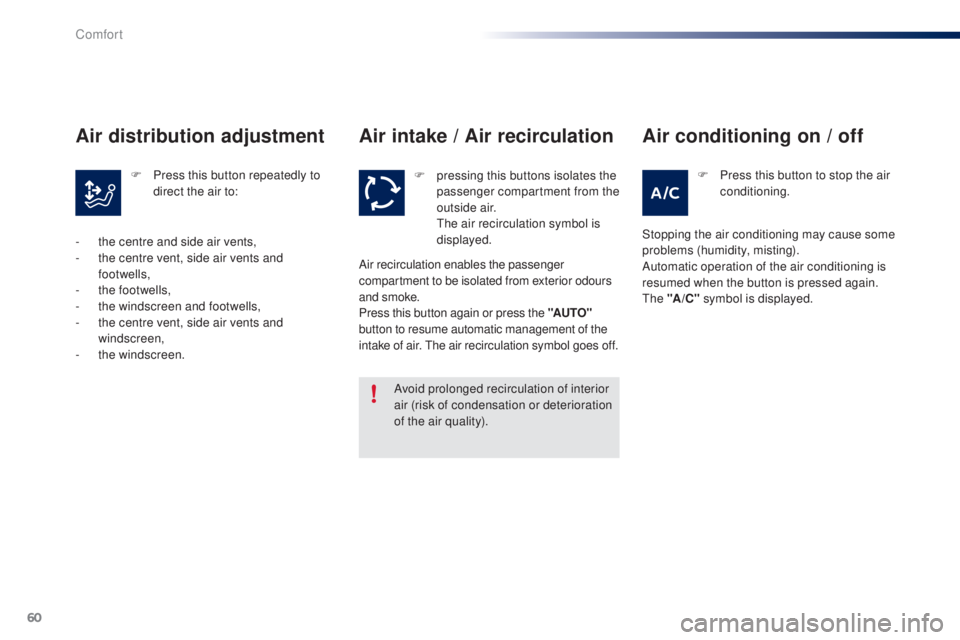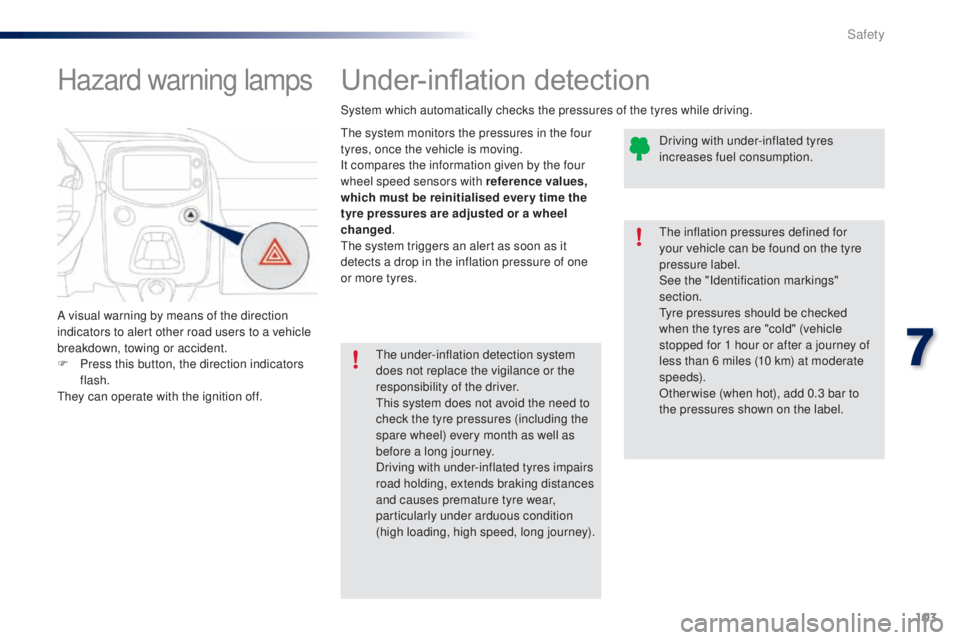Page 59 of 256
57
Air intake / Air recirculation
the recirculation of interior air insulates the
passenger compartment from exterior odours
and smoke.
Return to exterior air intake as soon as possible
to prevent deterioration of the air quality and
the formation of mist.
Air conditioning On / Off
the air conditioning is designed to
operate effectively in all seasons,
with the windows closed.
It enables you to:
-
l
ower the temperature, in summer,
-
i
ncrease the effectiveness of the demisting
in winter, above 3°C.
Switching on
F Press this button, the associated indicator lamp comes on.
th
e air conditioning does not operate
when the air flow adjustment is set to off.
Switching off
F Press the button again, the associated indicator lamp switches off.
F
M
ove the manual control to the
left for the "Recirculation of
interior air" position.
F
M
ove the manual control to the
right to return to the "
ex
terior air
intake" position.
3
Comfort
Page 60 of 256

58
Automatic air conditioning
F Press the "AUTO" button. th
e "AUTO" symbol comes on.
the
air conditioning operates when the engine is running.
By pressing the "AUTO" button again, you can
choose from one of the following settings in
turn:
Automatic programme
Allows optimum operation of the
system.
Offers temperature control while
restricting air flow.
Dynamic air distribution mainly
towards the side air vents.
We recommend that you use this mode.
It provides optimised automatic control of
all of the following functions: passenger
compartment temperature, air flow, air
distribution and air intake, in accordance with
the comfort value that you have chosen.
th
is system is designed to operate effectively
in all seasons, with the windows and fabric roof
closed.
For your comfort, when the engine is switched
off, the settings are retained until the engine is
switched on again.
to p
revent too great a distribution of cold air
when the engine is cold, the air flow will only
reach its optimum level gradually.
Comfort
Page 62 of 256

60
Air intake / Air recirculation
Avoid prolonged recirculation of interior
air (risk of condensation or deterioration
of the air quality).F
p
ressing this buttons isolates the
passenger compartment from the
outside air.
t
h
e air recirculation symbol is
displayed.
Air recirculation enables the passenger
compartment to be isolated from exterior odours
and smoke.
Press this button again or press the "AUTO"
button to resume automatic management of the
intake of air. t
h
e air recirculation symbol goes off. F
P
ress this button to stop the air
conditioning.
Air distribution adjustment
- the centre and side air vents,
- t he centre vent, side air vents and
footwells,
-
t
he footwells,
-
t
he windscreen and footwells,
-
t
he centre vent, side air vents and
windscreen,
-
t
he windscreen. F
P
ress this button repeatedly to
direct the air to:
Air conditioning on / off
Stopping the air conditioning may cause some
problems (humidity, misting).
Automatic operation of the air conditioning is
resumed when the button is pressed again.
th
e "A /C " symbol is displayed.
Comfort
Page 63 of 256
61
Avoid driving for long periods with the air
conditioning switched off (risk of misting
and reduction of the air quality in the cabin).
th
is action switches off all of the functions of
the air conditioning system.
th
ermal comfort is no longer controlled. A
slight flow of air resulting from the movement of
the vehicle, remains perceptible however.
Pressing the "AUTO" button again reactivates
the system with the values set before it was
switched off.
Switching the system off
F Press the air flow adjustment button until the fan symbol
disappears.
3
Comfort
Page 64 of 256

62
Front demist - defrost
these markings indicate the control positions for rapid demisting or defrosting of the
windscreen and side windows.
During the winter period, direct the side air vents towards the side glasses to optimise
their demisting and defrosting.
With the heating /
ventilation system
F Put the temperature and air flow controls to the dedicated marked position.
F
P
ut the air distribution control to the
"Windscreen" position.
With the manual air
conditioning system
F Put the temperature and air flow controls to the dedicated marked position.
F
P
ut the air intake control to the "
ex
terior air
intake" position
(
manual control to the right).
F
P
ut the air distribution control to the
"Windscreen" position.
F
S
witch on the air conditioning by pressing
the appropriate button; the indicator lamp
in the button comes on.
With automatic air
conditioning system
F Press this button. th e indicator lamp in the button comes on.
F
P
ress this button again to switch it off.
t
h
e indicator lamp in the button goes off.
Other settings (air flow, air distribution...)
are controlled automatically.
Comfort
Page 65 of 256
63
Rear screen demist - defrost
Switching off
Switching on
F Press this button again to switch off the
heated rear screen.
t
h
e indicator lamp associated with the
button goes off.th
e heated rear screen can only operate when
the engine is running. F
S
witch off the demisting/defrosting
of the rear screen and door mirrors
(depending on version) as soon
as appropriate, as lower current
consumption results in reduced fuel
consumption.
F
P
ress this button to demist /defrost the rear
screen and, depending on version, the
door mirrors.
t
h
e indicator lamp associated with the
button comes on.
th
e control button is located on the heating / ventilation or air conditioning system control
panel.
3
Comfort
Page 86 of 256
84
Going into engine START mode
this indicator lamp goes off and the
engine starts automatically:
-
w
hen you fully depress the clutch pedal. StA
Rt mode is invoked automatically when:
- y ou open the driver's door,
-
y
ou open the bonnet,
-
y
ou unfasten the driver's seat belt,
-
s
ome special conditions (battery charge,
engine temperature, braking assistance,
descending a steep gradient, adjustment of
the air conditioning...) where the engine is
needed for control of a system.
Special cases: START invoked
automaticallyIn the event of a fault with the system,
this warning lamp flashes in the
instrument panel.
Operating fault
Have it checked by a Pe ugeOt dealer or a
qualified workshop.
Driving
Page 105 of 256

103
Under-inflation detection
the system monitors the pressures in the four
tyres, once the vehicle is moving.
It compares the information given by the four
wheel speed sensors with reference values,
which must be reinitialised ever y time the
tyre pressures are adjusted or a wheel
changed.
th
e system triggers an alert as soon as it
detects a drop in the inflation pressure of one
or more tyres.
th
e under-inflation detection system
does not replace the vigilance or the
responsibility of the driver.
th
is system does not avoid the need to
check the tyre pressures (including the
spare wheel) every month as well as
before a long journey.
Driving with under-inflated tyres impairs
road holding, extends braking distances
and causes premature tyre wear,
particularly under arduous condition
(high loading, high speed, long journey).
System which automatically checks the pressures of the tyres while driving.
th
e inflation pressures defined for
your vehicle can be found on the tyre
pressure label.
See the "Identification markings"
section.
ty
re pressures should be checked
when the tyres are "cold" (vehicle
stopped for 1 hour or after a journey of
less than 6 miles (10 km) at moderate
speeds).
Other wise (when hot), add 0.3 bar to
the pressures shown on the label. Driving with under-inflated tyres
increases fuel consumption.
Hazard warning lamps
A visual warning by means of the direction
indicators to alert other road users to a vehicle
breakdown, towing or accident.
F
P
ress this button, the direction indicators
flash.
th
ey can operate with the ignition off.
7
Safety